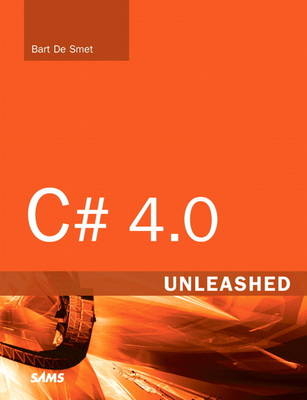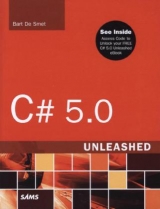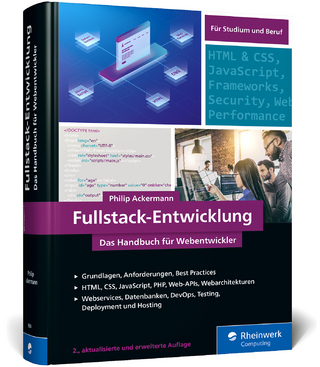
C# 4.0 Unleashed
Sams Publishing (Verlag)
978-0-672-33079-7 (ISBN)
- Titel ist leider vergriffen;
keine Neuauflage - Artikel merken
Provides valuable insight into the C# language and the .NET Framework - not just "what" but also the "how" and "why" of the language and framework features
Covers using C# with new major technologies, such as cloud computing, SharePoint, and ASP.NET MVC
Author is Microsoft insider
Will be day and date with the release of C# 4.0
Bart J.F. De Smet is a software development engineer on Microsoft’s Cloud Programmability Team, an avid blogger, and a popular speaker at various international conferences. In his current role, he’s actively involved in the design and implementation of Reactive Extensions for .NET (Rx) and on an extended “LINQ to Anything” mission. You can read about Bart’s technical adventures on his blog at http://blogs.bartdesmet.net/bart. His main interests include programming languages, virtual machines and runtimes, functional programming, and all sorts of theoretical foundations. In his spare time, Bart likes to hike in the wonderful nature around Seattle, read technical books, and catch up on his game of snooker. Before joining Microsoft in October 2007, Bart was active in the .NET community as a Microsoft Most Valuable Professional (MVP) for C#, while completing his Bachelor of Informatics, Master of Informatics, and Master of Computer Science Engineering studies at Ghent University, Belgium.
Introduction 1
Part I Introduction
Chapter 1 Introducing the .NET Platform 5
A Historical Perspective5
Win32 Programming in C 6
Raising the Abstraction Level with MFC and C++ 6
Component-Driven Development with COM 7
Windows Development for the Masses in Visual Basic 7
Reaching Out to the Web with Windows DNA8
Reaching Out to Java with J++8
Time for Lightning8
A 10,000-Feet View of the .NET Platform 9
The .NET Platform 9
The Common Language Infrastructure
The Multilanguage Aspect of .NET
Introducing .NET Assemblies
The Common Type System Explained
What’s Type Safety?
Primitive Types
Classes, Structures, and Enumerations
Interfaces
Delegates
Members
A Note on Generics
The Role of the Common Language Specification
Executing Managed Code
The Assembly Manifest
IL Code
Metadata
Mixing Languages
Diving into the Common Language Runtime
Bootstrapping the Runtime
Assembly Loading
Application Domains
JIT Compilation
Native Image Generation
Automatic Memory Management
Exception Handling
Code Access Security
Interoperability Facilities
The Base Class Library
Summary
Chapter 2 Introducing the C# Programming Language
The Evolution of C#
C# 1.0: Managed Code Development, Take One
C# 2.0: Enriching the Core Language Features
C# 3.0: Bridging the Gap Between Objects and Data
C# 4.0: Reaching Out to Dynamic Languages
A Sneak Peek at the Future
Multiparadigm
Language-Shaping Forces
Compiler as a Service
Taming the Concurrency Beast
Summary
Chapter 3 Getting Started with .NET Development Using C#
Installing the .NET Framework
The .NET Framework Version Landscape
.NET Framework 4
Running the Installer
What Got Installed?
Your First Application: Take One
Writing the Code
Compiling It
Running It
Inspecting Our Assembly with .NET Reflector
Visual Studio 2010
Editions
Expression
Installing Visual Studio 2010
A Quick Tour Through Visual Studio 2010
Your First Application: Take Two
New Project Dialog
Solution Explorer
Project Properties
Code Editor
Build Support
Debugging Support
Object Browser
Code Insight
Integrated Help
Designers
Server Explorer
Database Mappers
Unit Testing
Team Development
Summary
Part II C#—The Language
Chapter 4 Language Essentials
The Entry Point
A Trivial Console Application
Method Signatures
Allowed Entry-Point Signatures
Running the Sample
Under the Hood
Keywords
Contextual Keywords
Syntax Highlighting in Visual Studio
A Primer on Types
Code and Data
Types, Objects, and Instances
Variables
Classes and Other Types
Built-In Types
Integral Types
Floating-Point Types
The Decimal Type
The Boolean Type
The String Type
Object
Dynamic Typing
A Word on CLS Compliance
A Matter of Style: Aliases or Not?
Local Variables
Declaration
Scope
Assignment
Constants
Implicitly Typed Local Variable Declarations
Intermezzo on Comments
Single-Line Comments
A Primer to Preprocessing Directives
Delimited Comments
Documentation Comments
Arrays
Internal Representation
Single-Dimensional Arrays
Array Initializers
Jagged Arrays
Multidimensional Arrays
The Null Reference
What’s Null Really?
A Common Source of Bugs
Nullable Value Types
Internal Representation
Use in C#
A Type Background
Summary
Chapter 5 Expressions and Operators
What Are Expressions?
Arity of Operators
Precedence and Associativity
Evaluation of Subexpressions
The Evaluation Stack
Arithmetic Operators
Integer Arithmetic
Floating-Point Arithmetic
Decimal Arithmetic
Character Arithmetic
Unary Plus and Minus
Overflow Checking
Arithmetic with Nullables
String Concatenation
Shift Operators
Relational Operators
Equality for Different Types
Lifted Operators
Logical Operators
Integral Bitwise Logical Operators
Use for Enumerations
Boolean Logical Operators
Nullable Boolean Logic
Conditional Operators
Under the Hood
An Operator’s Result Type
Associativity
Null-Coalescing Operator
Assignment
Decaration Versus (Simple) Assignment
Compound Assignment
A Gentle Introduction to Definite Assignment
Postfix and Prefix Increment and Decrement Operators
Summary
Chapter 6 A Primer on Types and Objects
Implicit Versus Explicit Conversions
Cast Expressions
The is Operator
The as Operator
Intermezzo: The Mythical Type Switch
The typeof Operator: A Sneak Peek at Reflection
Default Value Expression
Creating Objects with the new Operator
Behind the Scenes of Constructors
Object Initializers
Collection Initializers
Member Access
A First Look at Dynamic Typing
Invocation Expressions
Method Invocation
Delegate Invocation
Element Access
Summary
Chapter 7 Simple Control Flow
What Are Statements, Anyway?
Expression Statements
Method Calls
Assignments
Pre- and Post-Increment/Decrement
The Empty Statement
Blocks
Declarations
Selection Statements
The if Statement
The switch Statement
Iteration Statements
The while Statement
The do...while Statement
The for Statement
The foreach Statement
A Peek at Iterators
Loops in the Age of Concurrency
The goto Statement
The return Statement
Summary
Chapter 8 Basics of Exceptions and Resource Management
Exception Handling
Exceptions Are Objects
Causes of Exceptions
Throwing Exceptions
Handling Exceptions
The finally Clause
Deterministic Resource Cleanup
Garbage Collection in a Nutshell
Object Disposal
The using Statement
Implementing IDisposable
(In)appropriate Use of IDisposable
Locking on Objects
Under the Hood
The lock Statement
Intermezzo: Code Generation for Lock
Be Careful with Locks
Summary
Chapter 9 Introducing Types
Types Revisited
Classes Versus Structs
References Versus Values
Heap Versus Stack
Boxing
The Dangers of Mutable Value Types
Type Members
Visibility
Static Versus Instance
Partial Types
Summary
Chapter 10 Methods
Defining Methods
Return Type
Parameters
Value Parameters
Reference Parameters
Output Parameters
Parameter Arrays
Optional and Named Parameters
Overloading
Defining Method Overloads
Method Groups
Overload Resolution
Extension Methods
Defining Extension Methods
Overload Resolution
Using Extension Methods
How the Compiler Marks and Finds Extension Methods
Partial Methods
Extern Methods
Refactoring
Code Analysis
Summary
Chapter 11 Fields, Properties, and Indexers
Fields
Declaring Fields
Accessing Fields
Initializing Fields
Read-Only Fields
Constants
Volatile Fields
An Intermezzo About Enums
Why Enums Matter
Underlying Types
Assigning Values to Members
The System.Enum Type
Flags
Revisiting the switch Statement
Behind the Scenes
Properties
Declaring and Using Properties
Auto-Implemented Properties
How Properties Work
Indexers
Defining Indexers
How Indexers Are Implemented
Summary
Chapter 12 Constructors and Finalizers
Constructors
Instance Constructors
Static Constructors
Destructors (Poorly Named Finalizers)
Defining Finalizers in C#
How Finalizers Are Run
How Finalizers Are Implemented
Disposal Before Collection: IDisposable
Summary
Chapter 13 Operator Overloading and Conversions
Operators
Defining Operators
How Operators Are Found
Nullability and Lifted Operators
Which Operators Can Be Overloaded?
Implementing Equality Operations
How Operators Are Translated
Conversions
Built-In Conversions
User-Defined Conversions
Other Conversion Mechanisms
Summary
Chapter 14 Object-Oriented Programming
The Cornerstones of Object Orientation
A Historical Perspective
Encapsulation
Inheritance
Polymorphism
Types in Pictures
Inheritance for Classes
Single Inheritance for Classes
Multiple Inheritance for Interfaces
Blocking Inheritance
Hiding Base Class Members
Protected Accessibility
Polymorphism and Virtual Members
Virtual Members
Overriding Virtual Members
Declaring Virtual Members
Sealing and Hiding: Take Two
How Virtual Dispatch Works
How Base Calls Work
Abstract Classes
Interfaces
Defining Interfaces
Some Design Recommendations
Implementing Interfaces
Summary
Chapter 15 Generic Types and Methods
Life Without Generics
A Real-World Example with Collections
Performance Worries
Getting Started with Generics
Declaring Generic Types
Using Generic Types
Performance Intermezzo
Operations on Type Parameters
Default Values
Getting the Type’s Reflection Info Object
Generic Constraints
Interface-Based Constraints
Base Class Constraints
Default Constructor Constraint
Restriction to Value Types or Reference Types
Generic Methods
Co- and Contravariance
Annoyances with Generic Types
Broken Covariance for Array Types
Safety Guarantees
Generic Co- and Contravariance
Under the Hood
Where to Use
Summary
Chapter 16 Collection Types
Nongeneric Collection Types
ArrayList
Hash Tables
Queue
Stack
Summary
Generic Collection Types
List
SortedDictionary and SortedList
Queue and Stack
Other Collection Types
Summary
Chapter 17 Delegates
Functional Programming
Historical Perspective
Programming with Functions
What Are Delegates?
Delegate Types
Delegate Instances
Anonymous Function Expressions
Closures: Captured Outer Variables
Lambda Expressions
Expression Trees
Invoking Delegates
Putting It Together: An Extensible Calculator
Case Study: Delegates Used in LINQ to Objects
Asynchronous Invocation
Combining Delegates
Summary
Chapter 18 Events
The Two Sides of Delegates
A Reactive Application
Using Delegates
Limitations on Plain Use of Delegates
Using .NET Events
How Events Work
Raising Events, the Correct Way
Add and Remove Accessors
Detach Your Event Handlers
Recommended Event Patterns
EventHandler and EventArgs
EventHandler
Designing Events for Use by Derived Classes
Case Study: INotifyProperty Interfaces and UI Programming
Events in UI Frameworks
Countdown, the GUI Way
Modern Approaches to Reactive Programming
Events Revisited
Pull Versus Push
Dictionary Suggest Revisited
Summary
Chapter 19 Language Integrated Query Essentials
Life Without LINQ
In-Memory Data
Relational Databases
XML
The Birth of LINQ
LINQ by Example
In-Memory Data
Relational Databases
XML
Query Expression Syntax
Why Query Expressions?
Getting Started
Source Selection Using a from Clause
Projection Using the Select Clause
Filtering Using a where Clause
Ordering Using the orderby Keyword
Grouping Using the group by Clause
Joining Using the join Clause
Continuing a Query Expression Using the into Clause
Bindings with the let Clause
Summary
Chapter 20 Language Integrated Query Internals
How LINQ to Objects Works
IEnumerable and IEnumerator Recap
LINQ to Objects Extension Methods
Iterators
Lazy Evaluation
How Iterators Work
Standard Query Operators
Source Generators
Restriction
Projection
Ordering
Grouping and Joining
Aggregation
Predicates
Set Theoretical and Sequencing Operators
Sequence Persistence
Remote Versus Local with AsEnumerable
The Query Pattern
All About Methods
Overloading Query Expression Syntax
Parallel LINQ
The Cost of Optimization
AsParallel
How PLINQ Works
AsOrdered
Tweaking Parallel Querying Behavior
Parallel Enumeration with ForAll
Expression Trees
Query Expression Translation
Homoiconicity for Dummies
Expression Trees for Query Expressions
IQueryable
Summary
Chapter 21 Reflection
Typing Revisited, Static and Otherwise
The Role of Metadata
The Multilanguage World
Taking Multilanguage to the Next Level
How Does All of This Relate to C# Programming?
Reflection
System.Type
A Primer on Application Extensibility
Reflection for Methods, Properties, Events, and More
Custom Attributes
Lightweight Code Generation
Hello LCG
A Toy Compiler for Arithmetic Expressions
Expression Trees
Compiler-Generated Expression Trees
The Expression Tree API
Using the ExpressionTreeVisitor
Summary
Chapter 22 Dynamic Programming
The dynamic Keyword in C# 4.0
The dynamic Type
Dynamic Typing Is Contagious
Deferred Overload Resolution
No System.Dynamic Type
When to Use dynamic: Case Study with IronPython
DLR Internals
Dynamic Call Sites and Binders
Dynamic Dispatch
Custom Dynamic Objects with DynamicObject
A Primer to DynamicMetaObject
Dynamic Operations
Overall Architecture
Office and COM Interop
Essentials of COM Interop
Simplified COM Interop in .NET 4
Case Study: COM Interop with Excel and Word
Summary
Chapter 23 Exceptions
Life Without Exceptions
Win32
COM
Lessons Learned
Introducing Exceptions
Exception Handling
try Statements
First-Chance Exceptions
Intermezzo on Historical Debugging with IntelliTrace
When and What to Catch
Beyond Your Control
Throwing Exceptions
Defining Your Own Exception Types
(In)famous Exception Types
DivideByZeroException
OverflowException
NullReferenceException
IndexOutOfRangeException
InvalidCastException
ArrayTypeMismatchException
TypeInitializationException
ObjectDisposedException
OutOfMemoryException
StackOverflowException
ExecutionEngineException
ArgumentException
ArgumentNullException
ArgumentOutOfRangeException
InvalidOperationException
NotImplementedException
NotSupportedException
FormatException
AggregateException
Summary
Chapter 24 Namespaces
Organizing Types in Namespaces
Once Upon a Time
Assemblies and Namespaces
Declaring Namespaces
Naming Conventions
Visibility
Name Clashes Within Namespaces
Importing Namespaces
Name Clashes Due to Imports
Using Aliases
Extern Aliases
Extension Methods
Summary
Chapter 25 Assemblies and Application Domains
Assemblies
Modules and Assemblies
Types of Assemblies
Assembly Properties
Naming, Versioning, and Deployment
Strong Naming
The Global Assembly Cache
Referencing Assemblies
How Assemblies Get Loaded at Runtime
Native Image Generation (NGEN)
Visibility Aspects
Embedded Resources
Type Forwarding
Reflection Flashback
Application Domains
Creating Application Domains
Cross-Domain Communication
The Managed Add-In Framework
Summary
Part III Working with Base Class Libraries
Chapter 26 Base Class Library Essentials
The BCL: What, Where, and How?
What Is Covered?
Default Project References
Namespaces Versus Assemblies
The System and mscorlib Assemblies
System.Core’s Story of Red Bits and Green Bits
The Holy System Root Namespace
Primitive Value Types
Working with Arrays
The Math Class
BigInteger: Beyond 32-bit and 64-bit Integers
Complex Numbers
Generating Random Numbers
Working with Date and Time
GUID Values
Nullability Revisited Briefly
The Uri Type
Interacting with the Environment
Leave the GC Alone (Most of the Time)
Native Interop with IntPtr
Lazy Initialization Using Lazy
Tuple Types
Facilities to Work with Text
Formatting Text
Parsing Text to Objects
Regular Expressions
Commonly Used String Methods
The StringBuilder Class
Text Encoding
Summary
Chapter 27 Diagnostics and Instrumentation
Ensuring Code Quality
Code Analysis
Asserts and Contracts
Diagnostic Debugger Output
Controlling the Debugger
Logging Stack Traces
Measuring Performance Using StopWatch
Instrumentation
Using Event Logs
Monitoring with Performance Counters
Other Manageability Frameworks
Controlling Processes
Querying Process Information
Starting Processes
Summary
Chapter 28 Working with I/O
Files and Directories
Listing Drives
Working with Directories
Working with Paths
The FileInfo Class
Monitoring File System Activity
Readers and Writers
The File Class
TextReader and TextWriter
Streams: The Bread and Butter of I/O
Memory Streams
Working with Files: Take Two
BinaryReader and BinaryWriter
Asynchronous Read and Write Operations
Streams Are Everywhere
A Primer to (Named) Pipes
Memory-Mapped Files in a Nutshell
Overview of Other I/O Capabilities
Summary
Chapter 29 Threading and Synchronization
Using Threads
Explaining the Concept of Threads
The Managed Code Story
Where It All Starts: The Thread Class
More About a Thread’s Life Cycle
Managed Thread Characteristics
Dealing with Exceptions
Thread-Specific State
Essential Threading Debugging
Techniques
Thread Pools
.NET’s Thread Pool
Synchronization Primitives
Atomicity (or Lack Thereof) Illustrated
Monitors and the lock Keyword
Mutexes
Semaphores
More Advanced Locks
Signaling with Events
Interlocked Helpers
More Synchronization Mechanisms
BackgroundWorker
Summary
Chapter 30 Task Parallelism and Data Parallelism
Pros and Cons of Threads
Cutting Costs
An Ideal Number of Threads?
The Task Parallel Library
Architecture
Declarative Versus Imperative
What Are Tasks?
Task Parallelism
Creating and Starting Tasks
Retrieving a Task’s Result
Dealing with Errors
Continuations
Cancellation of Tasks
Parallel Invocation
Waiting for Multiple Tasks
How the Task Scheduler Works
Data Parallelism
Parallel For Loops
Parallel Foreach Loops
Summary
9780672330797 TOC 12/16/2010
| Erscheint lt. Verlag | 20.1.2011 |
|---|---|
| Verlagsort | Indianapolis |
| Sprache | englisch |
| Maße | 180 x 226 mm |
| Gewicht | 1948 g |
| Themenwelt | Mathematik / Informatik ► Informatik ► Programmiersprachen / -werkzeuge |
| ISBN-10 | 0-672-33079-2 / 0672330792 |
| ISBN-13 | 978-0-672-33079-7 / 9780672330797 |
| Zustand | Neuware |
| Informationen gemäß Produktsicherheitsverordnung (GPSR) | |
| Haben Sie eine Frage zum Produkt? |
aus dem Bereich



